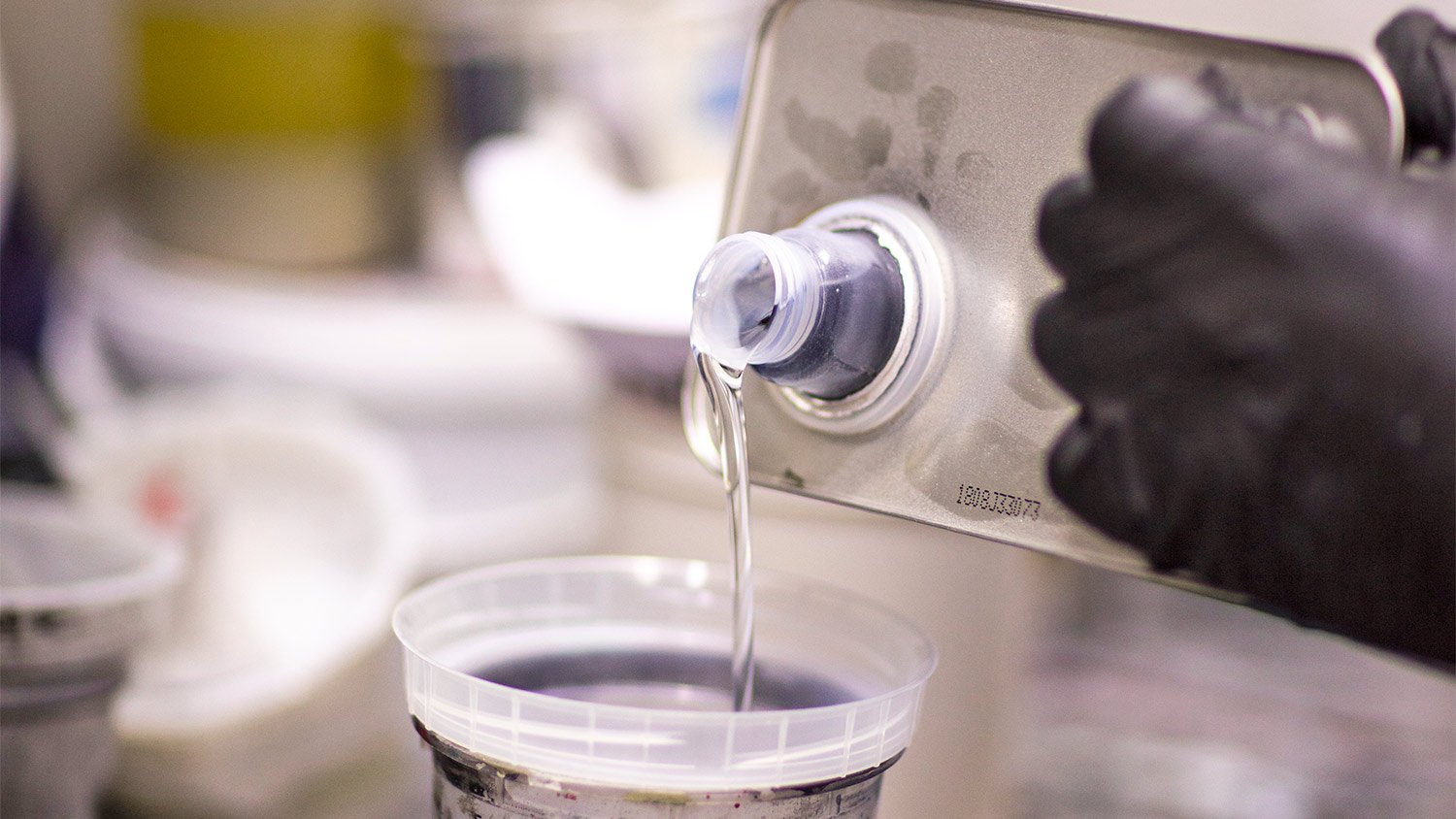
Wondering about the cost to paint a fireplace? Get a detailed guide to prices, key factors, and money-saving tips for your fireplace painting project.
Mineral spirits are a paint thinner, but not all paint thinners are mineral spirits


Mineral spirits are lower in toxins and odors than paint thinners.
Mineral spirits evaporate more slowly than paint thinners, making them better for soaking painting tools.
Paint thinners have more solvency than mineral spirits, so they clean quickly and can even remove dried paint.
Paint thinners are less expensive than mineral spirits.
These days, most people use latex paints around the home, eliminating the need for paint thinners. However, some people still rely on oil paints, which need to be diluted and cleaned with something other than water. Many people working with oil paints for the first time may wonder what the difference is between mineral spirits versus paint thinner. Ultimately, mineral spirits are a type of paint thinner, but there are other types, including turpentine, acetone, toluene, and naphtha.

Mineral spirits describe the product’s composition, whereas paint thinner refers to the product’s function. Mineral spirits are mineral-based paint thinners made from petroleum distillates with no additives. Paint thinner is a blanket term for anything that can thin paint. These products are mineral-based as well, but have additives. For this article, we will focus on paint thinners other than mineral spirits to emphasize the difference between the two.
| Category | Mineral Spirits | Paint Thinner |
|---|---|---|
| Best For | Soaking brushes and rollers | Quickly cleaning brushes and rollers |
| Other Uses | Cleaning tar, oil spills, and other messes | Removing dried paint from wood, drywall, steel, and aluminum among other materials |
| Odor and Toxicity | Lower in VOCs; odorless versions available | Higher in VOCs |
| Average Cost | $20–$25 per gallon | $15–$20 per gallon |
| Safety Precautions | Wear safety goggles, gloves, respiratory protection, and protective clothing; use in small amounts | Keep a window open when using indoors; wear long sleeves and gloves |
| Evaporation | Evaporates more slowly | Evaporates more quickly |
Oil-based paints contain higher volatile organic compounds (VOCs) than latex paints. To limit your exposure to VOCs while painting indoors, keep the area well-ventilated, wear respiratory protection, and avoid the painted area for at least 72 hours once finished.
Mineral spirits are additive-free paint thinners made from 100% petroleum distillates. Mineral spirits can fall into one of two categories: blended or unblended. The former consists solely of petroleum distillates while the latter is mixed with other substances like turpentine.
| Pros | Cons |
|---|---|
| Less toxic than most paint thinners | More expensive than other paint thinners |
| Minimal odors (an odorless version is available) | Cannot be used with latex paint |
| Less volatile | Mildly irritating to the skin |
| Can clean other products | Highly flammable |
| Difficult to dispose of |
Best for:
The majority of oil painting projects
All indoor applications
Those with health conditions, children, or pets
Cleaning other messes
Mineral spirits are the right option for those with respiratory issues, odor sensitivities, pets, and small children. They’re also useful for those working indoors as they don't require as much ventilation.
Mineral spirits evaporate more slowly because of their reduced volatility. This makes it better for soaking painting tools like rollers and brushes, and makes noticeable brush strokes less likely to occur.
While both paint thinner and mineral spirits can be used to clean oil spills, tar, and other messes, the reduced volatility, odor, and toxicity of mineral spirits make them a preferable choice—especially for indoor applications.
The biggest drawback of mineral spirits is the price, as they often cost as much as 50% more than other paint thinners at roughly $25 to $50 per gallon. The price can make them cost-prohibitive for larger outdoor projects. However, for most individuals, the price difference is negligible enough to overlook since most people do not use large quantities of paint solvents.
Mineral spirits also can’t be used on water-based paints, and should only be used on oil-based paints, stains, spills, and varnishes. Like other paint thinners, mineral spirits can be difficult to dispose of and must be brought to an approved disposal facility.
When people talk about paint thinner, they mean a petroleum-based variation, but some, like turpentine, contain no petroleum. Most paint thinners contain additives. If you see a container with the generic name “paint thinner” rather than a specific type of compound, it is likely a less refined version of mineral spirits blended with other solvents, making it more odorous and volatile than pure mineral spirits.
| Pros | Cons |
|---|---|
| Less expensive than mineral spirits | Highly volatile |
| Increased solvency | More odorous than mineral spirits |
| Some can remove dried paint | Highly flammable |
| Irritating to the skin |
Best for:
Large outdoor projects
Cleaning brushes and rollers quickly outdoors
Removing already-dried paint
At $15 to $20 per gallon, paint thinner is usually much cheaper than mineral spirits, making it a better option when budget is the top priority.
Many paint thinners have more solvency than mineral spirits, meaning they can clean faster and more efficiently. Turpentine can even remove dried paint, whereas mineral spirits can only clean it when wet.
In general, paint thinners are more volatile and toxic than mineral spirits and are highly flammable. Only use them in well-ventilated spaces and away from direct sunlight and open flames.
Paint thinners cannot be dumped in your sink or thrown in the trash. Instead, these must be brought to your local waste or recycling facility for disposal. Similarly, don’t forget to wear safety materials like gloves and goggles during use.
Here’s a closer look at how these two products stack up when it comes to factors like price and ability to be used indoors.
Paint thinner, usually between $15 and $20 a gallon, can cost 40 to 50% less than mineral spirits, priced around $20 to $25 a gallon. The good news is you don’t need a lot of either for most jobs, so the small price difference won’t have a big impact on a budget.
Mineral spirits are made from 100% petroleum distillates. While some paint thinners are equally loaded with petroleum, not all are. Some contain lower amounts of petroleum, while others are entirely free of it. Turpentine, for example, is made from tree resin.
Ask any professional interior painter in your area, and chances are they’ll agree that mineral spirits are preferred for indoor use because they are less volatile, less toxic, and have less odor. Other paint thinners have high levels of VOCs and should only be used in well-ventilated areas, ideally outside.
Paint thinner has greater solvency than mineral spirits, so it’s able to clean faster and more thoroughly, making it better suited to tasks like removing dried paint. This makes a paint thinner such as turpentine the better choice for a challenging job such as removing dried paint.
The comparative purity and low volatility of mineral spirits make them the best choice for thinning oil paints and varnishes, giving the smoothest and most even results. In fact, some products are specifically designed to be used with mineral spirits, and using other paint thinners could leave you with unpredictable results.
Need to leave your brushes or rollers to soak in a solvent overnight? Mineral spirits don’t evaporate quickly making them a better choice when you must soak something for a while.
With its lower toxicity and low odors, mineral spirits are a surprisingly versatile cleaner that can be used on more than just oil paint—including tar, oils, and other difficult-to-clean spills and stains. Paint thinner, meanwhile, is generally only used to clean up oil-based paints.
Not every job calls for a heavy-duty substance. Here’s when to opt out of both mineral spirits and paint thinner.
Both mineral spirits and traditional paint thinners cannot be used on latex paints, and doing so will separate the pigments from the solvents in the paint. Instead, use water to dilute latex paint, and use soap and water or a latex-based paint thinner to clean up latex paint.
The potency of both types of paint thinners will burn through asphalt and lead to the need for costly repairs.
Paint thinners can only be used to strip oil paints, never water-based options like latex paint. Similarly, you’ll want to make sure that they’re formulated for the specific material you’re working on, whether that be wood, steel, or something else.
Just because paint thinners are highly flammable doesn’t mean they should be used to start a fire for something like a barbecue. They can cause explosions and circulate harmful VOCs at a faster rate.
From average costs to expert advice, get all the answers you need to get your job done.

Wondering about the cost to paint a fireplace? Get a detailed guide to prices, key factors, and money-saving tips for your fireplace painting project.

Looking to breathe new life into your space with a ceiling refresh? Learn about the cost to paint a ceiling and what factors can affect your total.

How much does it cost to paint a room? Learn what you’ll pay to give your space a makeover, depending on room size, paint type, the pro you hire, and more.

Whether you want to create a showstopping accent wall or change the color of an entire room, these tips will help make painting walls black a breeze.

Ready to remake your bedroom or home office? Avoid a sticky situation with these nine tried-and-true tips for peel-and-stick wallpaper.

If you’re painting your home and wondering, “How much paint do I need for my project?” there’s a simple math equation you can do to find the answer.